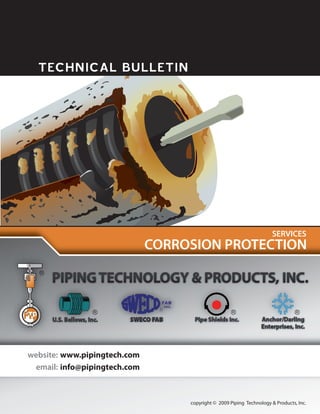Corrosion protection
- 1. TECHNICAL BULLETIN www.pipingtech.com info@pipingtech.com website: email: copyright ÂĐ 2009 Piping Technology & Products, Inc. SERVICES CORROSION PROTECTION
- 2. TECHNICAL BULLETIN SERVICES CORROSIONPROTECTION Methods of Protecting against Corrosion This technical bulletin will consider four methods of protecting carbon steel pipe supports components from corrosion; painting, zinc coatings, hot dip galvanizing, and combina- tions of these. Painting has an advantage when appearance and choice of color are important. Modern painting systems may be appropriate protection in certain environments. Paint pro- videsâbarrierâprotection to a metal surface. The ability of zinc to provide cathodoic protection for carbon steel in addition to barrier protection is a fundamental advantage. In most cases the reduction in life-cycle costs justifies the small additional cost of galvanizing. Indeed paint- ing and galvanizing together can provide a synergistic benefit which may be justified in some cases. The use of zinc and galvanizing has a long history. The early patents for hot dip galvanizing were issued in France and England in 1836 and 1837. This technology was quickly adopted and was widely used in the late-1800s. In the United States we have bridges more than 100 years old which have galvanized structures. In addition, we have transmission towers and substa- tion structures that are over 70 years old. A pipe rack at a petrochemical plant near Houston was studied after 28 years of service. Measurements of the zinc thickness remaining provided a forecast of another 60 years of service. Pulp and paper mills use galvanized materials in most of their critical environments. It is important to understand the fundamentals which make this âoldâtechnology so cost effective in such a wide variety of applications. Electrochemistry of Zinc & Carbon Steel Corrosion is an electrochemical process which occurs when four elements are present; an an- ode which gives up electrons, a cathode which receives electrons, an electrolyte (which is usu- ally an aqueous solution of acids, bases, or salts) and a metallic current path. The rate at which corrosion occurs depends on the electric potential between the anodic and cathodic areas, the pH of the electrolyte, the temperature, and the water and oxygen available for chemical reac- tions.
- 3. Copyright ÂĐ 2009 Piping Technology & Products, Inc. email: info@pipingtech.com website: www.pipingtech.comPiping Technology & Products, Inc. PT&P Figure 1indicates how corrosion damages carbon steel. Note that the pitted area to the right is anodic and gives up electrons while the cathodic area to the left (where water and oxy- gen from the air are present) is where rust appears. The pitted area where the carbon steel is weakened is not where the rust appears. Hot dip galvanizing has two advantages over a zinc coating. During galvanizing, the molten zinc reacts with the carbon steel to form layers of zinc/iron alloys. Figure 3 shows a galvanized surface with 5 layers, the top layer is 100% zinc and the bottom layer is carbon steel. The alloy layers between have increased hard- ness to provide mechanical (barrier) protection and because of their zinc content they are also anodic rela- tive to carbon steel. The hardness of these alloy layers provides much more protection from scratches than paint can provide. This is important for most pipe supports applications. Zinc has a greater tendency to give up electrons than carbon steel, so when both are present, zinc becomes the anode and protects the carbon steel. Figure 2 indicates corrosion with the zinc giving up the elec- trons and becoming pitted while the carbon steel remains undamaged. From this we see that a zinc coating will protect carbon steel byâsacrific- ingâitself until the zinc is depleted. The rate of zinc depletion is relatively slow when the pH of the electrolyte is between 4 and 13, Zinc Carbon Steel e- Water Drop Rust Deposit Carbon Steel e-
- 4. TECHNICAL BULLETIN SERVICES CORROSIONPROTECTION Any coating which provides a barrier to the moisture and oxygen in the air will help protect carbon steel from corrosion. A properly painted surface will provide a barrier, but it is subject to scratching from contact with hard objects. Figure 4 illustrates how rust can grow and damage a painted surface when corrosion begins because the paint barrier is broken by a scratch. RUST PAINT LAYER Eta layer 100: Zn 70 DPN hardness Carbon Steel 159 DPN hardness Gamma layer 75 Zn 25% Fe Delta layer 90% Zn 10% Fe 224 DPN hardness Zeta layer 94% Zn 6% Fe 179 DPN hardness
- 5. Copyright ÂĐ 2009 Piping Technology & Products, Inc. email: info@pipingtech.com website: www.pipingtech.comPiping Technology & Products, Inc. PT&P Figure 5 illustrates the cathodic pro- tection provided when a galvanized surface is scratched. Duplex Systems usually require painting over galvanizing. Some of our customers have specified a duplex system. This is more expensive but it can be justified for certain corrosive environments or for appearanice. The American Galvanizing Association suggests the followingârule of thumbâto estimate the service life of a duplex system. (Duplex System Service Life) = 1.5* (Service Life: HDG Only) + (Service Life: Paint Only) *The synergistic multiplier of 1.5 is based on the barrier protection the paint provides for the galvanized surface. At Piping Technology and Products Inc., many customers have returned painted variable and constant spring supports which could no longer function due to corrosion. Costs must be considered during the specification of coatings for pipe supports. The owner and operator of a facility should consider life-cycle costs. Pipe supports are usually a relatively small percentage of the total cost of installing and operatting a power plant, petrochemical plant, paper mill or other major facility. The small additional cost of hot dip galvanizing the carbon steel components of pipe supports is most always a wise investment. For more information you may want to contact the following organization: American Galvanizing Association-AGA 12200 E. Illif #204 Aurora, CO 80014 ph 800-468-7732 National Association of Corrosion Engineers-NACE 1440 S. Creek Dr. Houston, Tx 77084 ph 713-492-0535 ZINC COATING (ANODE) EXPOSED STEEL IS PROTECTED STEEL BASE (CATHODE)





